With their swaying tentacles and colourful bodies, sea anemones are a pleasure to spot when diving. Often overlooked in favour of the shimmering shoals that swim above them, these invertebrates are a fundamental part of marine biodiversity and come in all sorts of colours, shapes and sizes. Intrigued by these funky sea creatures? Read on for our top ten anemone facts…
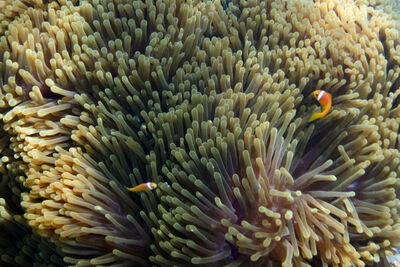
Anemones are animals, not plants
Although sea anemones have a plant-like appearance (and no skeletons or brains), these cool creatures are actually animals. Closely related to jellyfish, sea anemones belong to a group called Cnidarians (or 'nettle animals', because of their stinging cells).
Not only are anemones animals, but they are also tremendous predator (more on this later), and their lack of brains doesn't stop them from outsmarting other ocean dwellers.
Anemones are adaptable
Anemones are incredibly adaptable creatures, meaning that they can happily exist in most marine environments. While many species prefer warmer waters, like Egypt's Red Sea, you can also find sea anemones in colder waters. They can also thrive at various depths, from shallow waters to over 1000m deep.
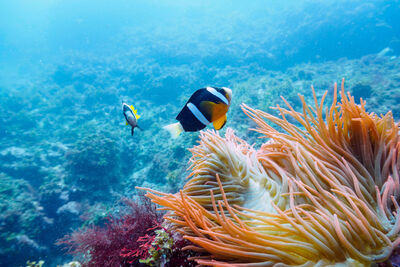
Anemones can (sometimes) can gender
Lacking males to mate with? That's not a problem for sea anemones. Some species are what's known as 'sequential hermaphrodites', meaning that they can change their gender at any point in their lives to mate and reproduce. While this is a pretty cool capability, it's not the case for all anemones - some species are split into male and female, like us mammals. Boring.
Anemones can release a paralysing neurotoxin
The sea is chock-full of dangerous predators, so to protect themselves from harm, anemones can release a paralysing neurotoxin through their tentacles. While the toxin isn't dangerous for humans, we'd still recommend that you refrain from touching anemones while diving.
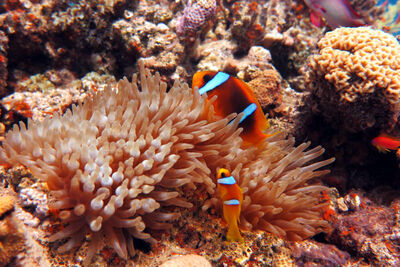
Anemones can form relationships with clownfish
Picture the opening scenes of Finding Nemo, and you might recall the titular clownfish swimming in and out of the peach-hued home he shares with his dad. That's right: that home is a sea anemone.
In real life, clownfish happily live in anemones, as their mucus-covered scales mean that they aren't affected by the neurotoxins we mentioned earlier. In return for this protection, clownfish will provide the anemone with food via their scraps and leftovers.
Anemones can move
One of our favourite (and perhaps most surprising) anemone facts is that they're are able to move. When they're in their larval stage - before they reach adulthood - anemones begin to swim, and it's in this period of life that they're at their most active.
Once they reach adulthood, anemones typically attach to a surface and stay there for the remainder of their lives, but if needs must, they can detach and drift along with the current.
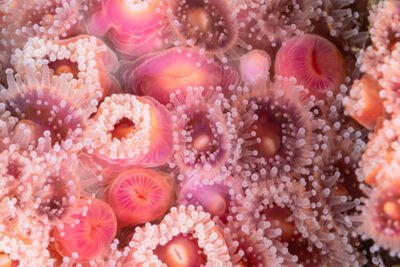
Anemones are long-lived
Sea anemones have impressive lifespans - they've been known to live for a whopping 100 years. This is excellent news for those hoping to catch sight of an anemone while diving, as their long lifespans and high reproductive rates mean that their populations aren't under threat.
Anemones can form relationships with algae
Much like with clownfish, anemones can form symbiotic relationships with algae. Zooxanthellae, a type of unicellular algae, live inside anemones and are protected from predators. In return, the algae use sunlight to photosynthesise, providing the anemone with nutrients, sugars and oxygen. Zooxanthellae do the same for coral, and the relationships between these teeny-tiny algae and their hosts are vital in maintaining a healthy reef.
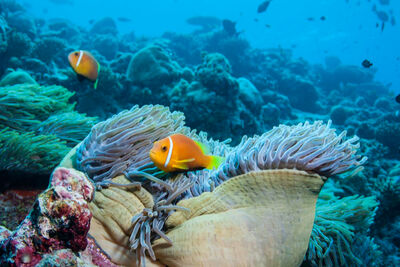
Anemones come in all shapes and sizes
Part of the reason we love to see anemones on our dives is their variety of shapes, sizes and colours. Anemones can range from as tiny as half an inch to as large as six feet across, and come in a range of alien-like shapes. These funky critters also come in kaleidoscopic colours, from vibrant greens to blues to purples, and some even have distinctive patterns.
Anemones are unlikely predators
As we said earlier, these quirky animals are, surprisingly, fantastic predators. Unlike a traditional predator, anemone don't actively hunt their prey - instead, they wait for creatures to pass them by before making their move. Once an unsuspecting small fish or plankton is in reach, the anemone uses its tentacles to snatch the victim and pop it into its mouth. This sneaky tactic, combined with the anemones' stinging tentacles, means that they have few predators themselves.
















